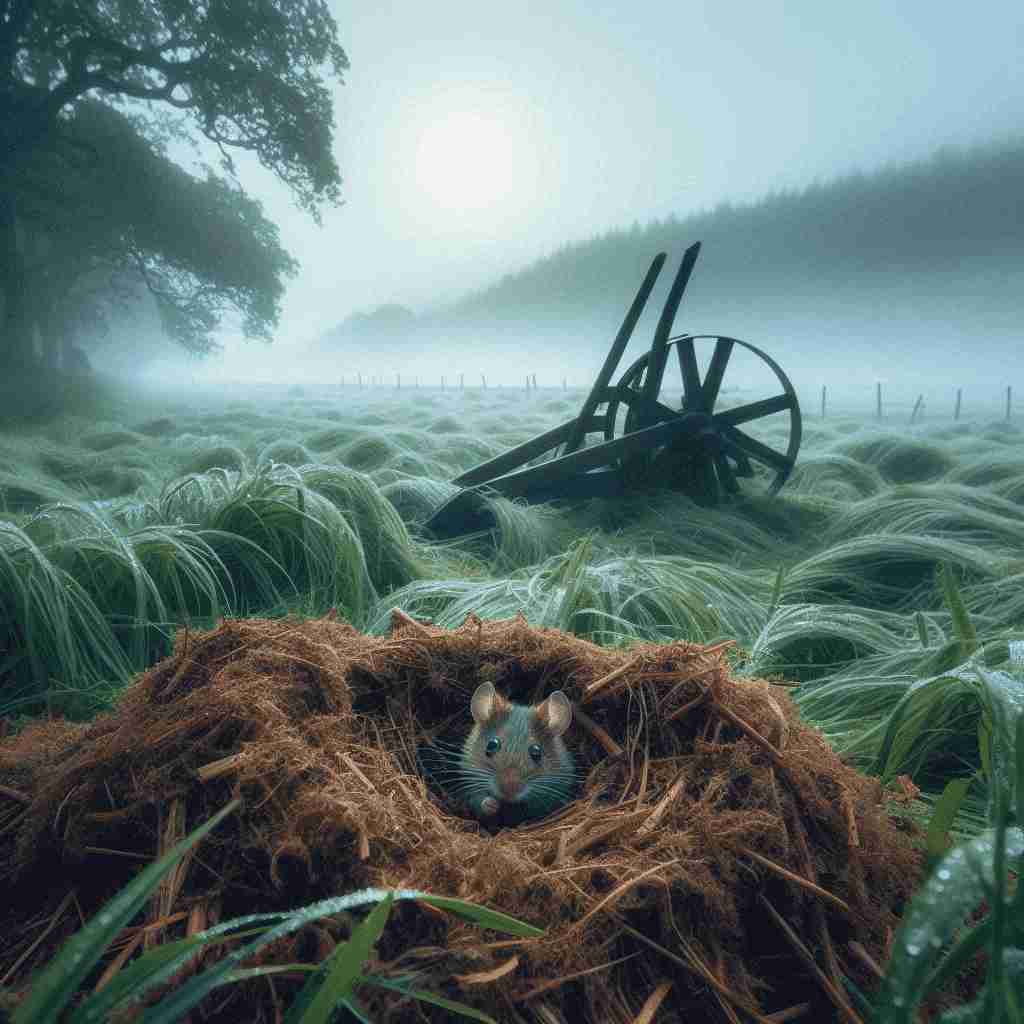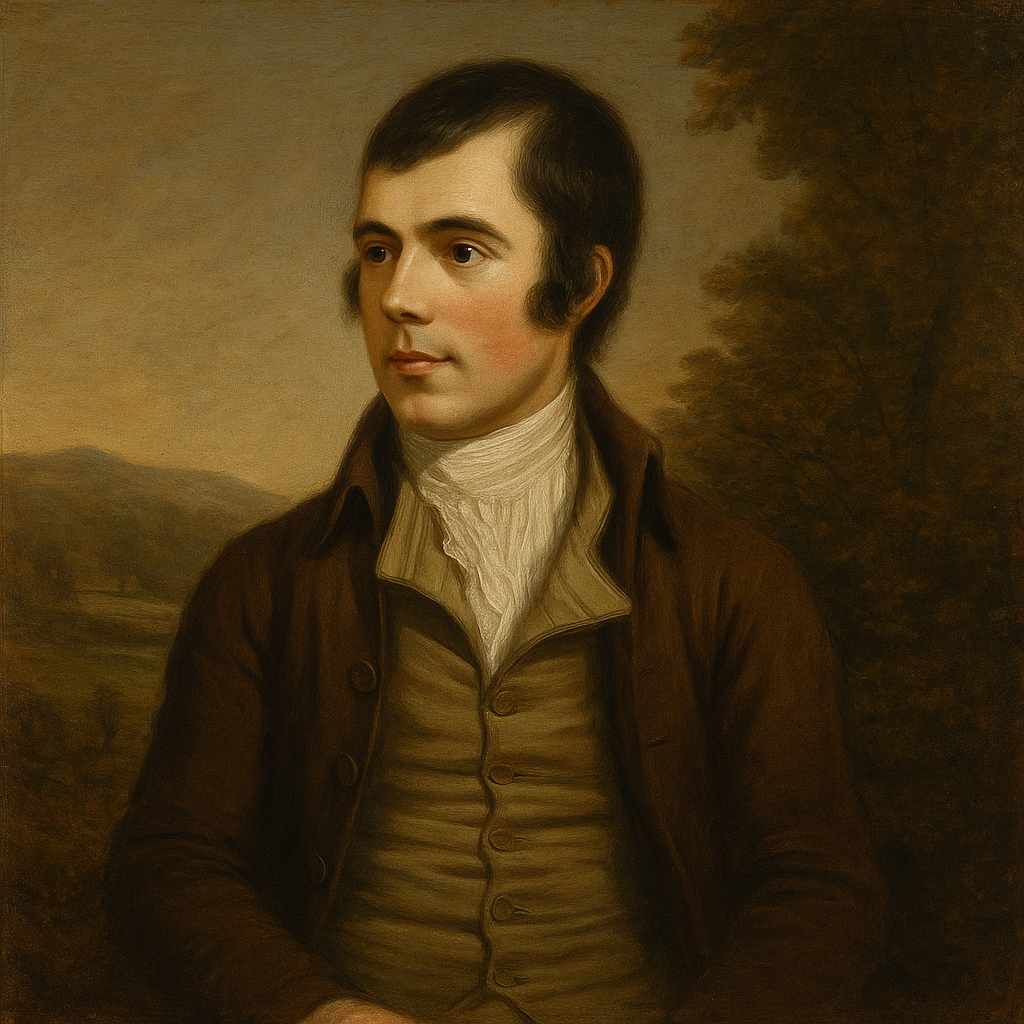To a Mouse
Robert Burns
1759 to 1796

On Turning her up in her Nest, with the Plough, November 1785.
Wee, sleeket, cowran, tim’rous beastie,
O, what a panic’s in thy breastie!
Thou need na start awa sae hasty,
Wi’ bickerin brattle!
I wad be laith to rin an’ chase thee
Wi’ murd’ring pattle!
I’m truly sorry Man’s dominion
Has broken Nature’s social union,
An’ justifies that ill opinion,
Which makes thee startle,
At me, thy poor, earth-born companion,
An’ fellow-mortal!
I doubt na, whyles, but thou may thieve;
What then? poor beastie, thou maun live!
A daimen-icker in a thrave
’S a sma’ request:
I’ll get a blessin wi’ the lave,
An’ never miss ’t!
Thy wee-bit housie, too, in ruin!
It’s silly wa’s the win’s are strewin!
An’ naething, now, to big a new ane,
O’ foggage green!
An’ bleak December’s winds ensuin,
Baith snell an’ keen!
Thou saw the fields laid bare an’ waste,
An’ weary Winter comin fast,
An’ cozie here, beneath the blast,
Thou thought to dwell,
Till crash! the cruel coulter past
Out thro’ thy cell.
That wee-bit heap o’ leaves an’ stibble
Has cost thee monie a weary nibble!
Now thou’s turn’d out, for a’ thy trouble,
But house or hald,
To thole the Winter’s sleety dribble,
An’ cranreuch cauld!
But Mousie, thou art no thy-lane,
In proving foresight may be vain:
The best laid schemes o’ Mice an’ Men
Gang aft agley,
An’ lea’e us nought but grief an’ pain,
For promis’d joy!
Still, thou art blest, compar’d wi’ me!
The present only toucheth thee:
But Och! I backward cast my e’e,
On prospects drear!
An’ forward tho’ I canna see,
I guess an’ fear!
Robert Burns's To a Mouse
Robert Burns's poem "To a Mouse" is a masterful exploration of the relationship between humans and nature, the fragility of existence, and the unpredictability of life. Written in 1785, this poem showcases Burns's ability to extract profound philosophical insights from a seemingly mundane incident: the destruction of a mouse's nest by a plow. Through his use of Scots dialect, vivid imagery, and a compassionate tone, Burns crafts a work that resonates with readers across centuries, inviting them to reflect on their place in the natural world and the universal experiences of loss and uncertainty.
The poem opens with the speaker directly addressing the mouse, establishing an intimate connection between human and animal. The use of diminutive terms like "Wee, sleeket, cowran, tim'rous beastie" not only describes the mouse's physical appearance and demeanor but also evokes a sense of tenderness and empathy. This immediately sets the tone for the poem's exploration of the shared vulnerability of all living creatures. The speaker's apology for frightening the mouse and his reluctance to chase it further humanizes the animal, bridging the gap between species and challenging the notion of human superiority.
Burns then delves into a critique of humanity's relationship with nature. The line "I'm truly sorry Man's dominion / Has broken Nature's social union" encapsulates a key theme of the poem: the disruption of the natural order by human activity. This sentiment reflects the growing awareness of environmental issues during the Enlightenment period, foreshadowing modern ecological concerns. By presenting the mouse as a "fellow-mortal," Burns emphasizes the interconnectedness of all life and questions the moral implications of humanity's dominance over nature.
The poem's structure, consisting of eight stanzas of six lines each, allows Burns to develop his ideas progressively. He moves from the immediate situation of the destroyed nest to broader philosophical reflections on existence. This progression is mirrored in the expanding scope of the imagery, from the intimate description of the mouse's "wee-bit housie" to the vast, barren fields and the approaching winter. This juxtaposition of the small and the large, the immediate and the eternal, adds depth to the poem's thematic exploration.
Burns's use of the Scots dialect is crucial to the poem's impact. It lends authenticity to the speaker's voice and grounds the work in a specific cultural context. However, the universality of the themes transcends linguistic barriers, making the poem accessible and relevant to a wide audience. The dialect also contributes to the poem's musicality, with its rich sounds and rhythms enhancing the emotional resonance of the verses.
As the poem progresses, Burns introduces one of its most famous and oft-quoted lines: "The best laid schemes o' Mice an' Men / Gang aft agley." This succinct statement encapsulates a central theme of the work: the futility of human planning in the face of unpredictable fate. By equating the mouse's simple plans for survival with humanity's grander ambitions, Burns highlights the shared vulnerability of all creatures to circumstances beyond their control. This idea is further developed in the final stanza, where the speaker reflects on his own uncertain future, adding a layer of personal poignancy to the philosophical musing.
The poem's conclusion presents a paradoxical twist. While the mouse's situation seems dire, the speaker envies its ability to live in the present moment, unburdened by regrets of the past or fears of the future. This final reflection adds complexity to the poem's treatment of the human-animal relationship, suggesting that in some ways, the simpler existence of the mouse might be preferable to the human condition of constant worry and anticipation.
Throughout "To a Mouse," Burns employs vivid imagery that brings the scene to life. The description of the "silly wa's the win's are strewin" and the "Winter's sleety dribble" creates a tangible sense of the harsh realities faced by both the mouse and the farmer. This attention to sensory detail not only enhances the poem's emotional impact but also reinforces its themes of nature's power and the precariousness of existence.
In conclusion, "To a Mouse" stands as a testament to Robert Burns's poetic genius. Through its carefully crafted verses, the poem invites readers to contemplate their relationship with nature, the unpredictability of life, and the shared experiences that unite all living beings. By finding profound meaning in a simple encounter with a mouse, Burns creates a work that continues to resonate with readers, offering insights into the human condition that remain relevant in our modern world. The poem's enduring appeal lies in its ability to blend empathy, philosophical depth, and linguistic beauty, making it a rich subject for literary analysis and personal reflection.
This text was generated by AI and is for reference only. Learn more
Want to join the discussion? Reopen or create a unique username to comment. No personal details required!



Comments
No comments yet. Be the first to comment!